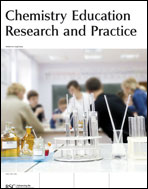Programmed instruction revisited: a study on teaching stereochemistry
Abstract
This study is aimed at comparing the success of programmed instruction with the conventional teaching approach on teaching stereochemistry, and whether gender has any effect on student success. Forty chemistry teacher trainees attending the same class in the Department of Chemistry Education in a large state university in eastern Turkey were the subjects of the study. Of the forty trainees twenty were selected as the experimental group and the other twenty as the control group. The study was implemented in a total of sixteen lecture hours (each 50 min) in four weeks (four lecture hours per week). The subject, stereochemistry in organic chemistry, was taught to the experimental group by the researcher through ‘programmed instruction’ and the control group was taught by the course lecturer through traditional teaching. The data collection tools were: Stereochemistry Achievement Test (SAT), programmed stages (frames), and the views of the students. An ANCOVA (Analysis of Co-Variance) showed that there was a statistically significant difference between programmed instruction and conventional teaching approach on the success level of students’ learning in stereochemistry. In addition, it was found that female students were more successful than their male counterparts in the experimental group. The findings suggest that programmed learning could be considered as a better alternative to conventional lecturing in teaching stereochemistry. [Chem. Educ. Res. Pract., 2006, 7 (1), 13-21]

 Please wait while we load your content...
Please wait while we load your content...